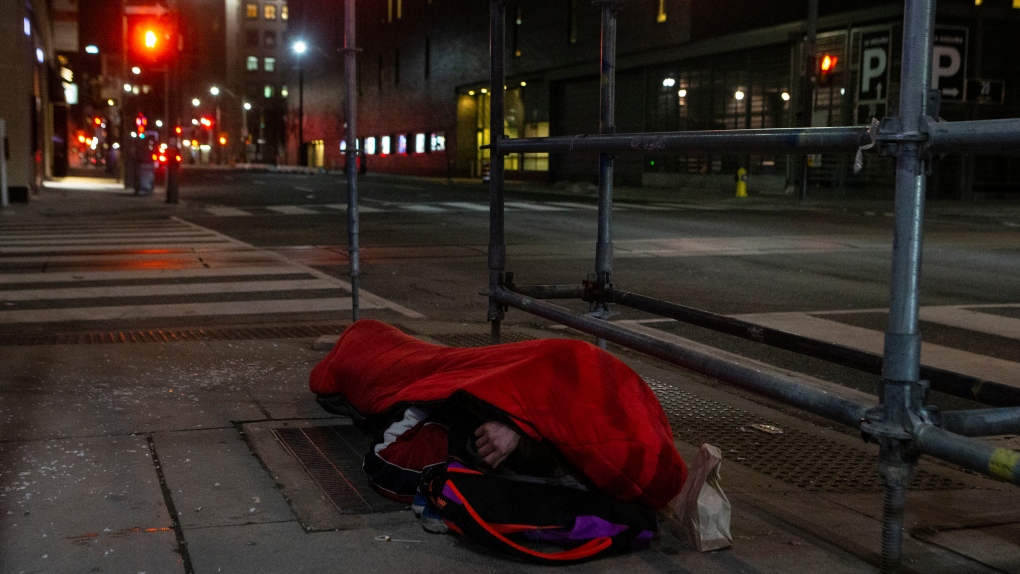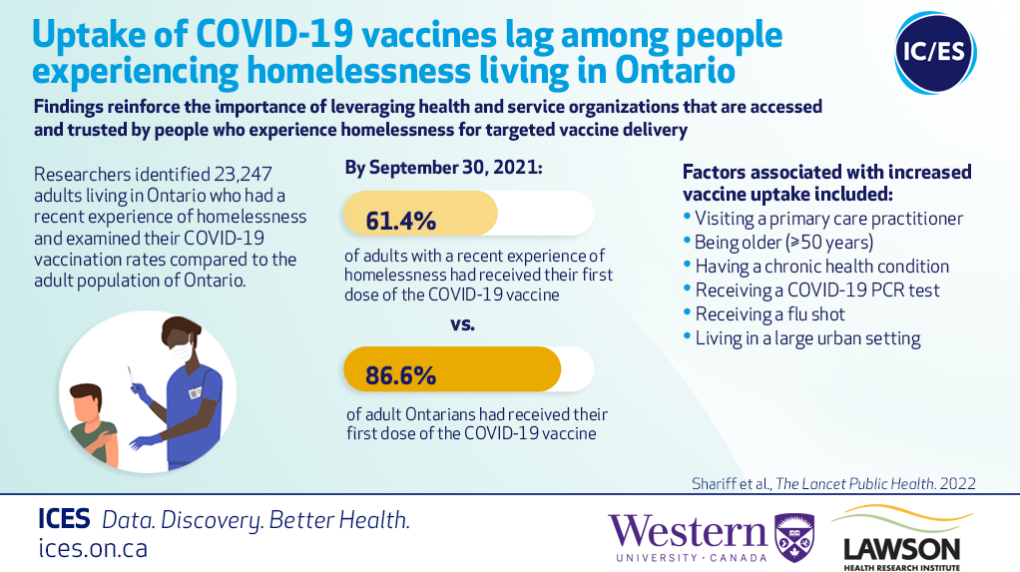Ontario's homeless community is falling behind in vaccine coverage as province drops pandemic restrictions
 A homeless man sleeps on the street, in Toronto, on Friday, March 11, 2022. THE CANADIAN PRESS/Chris Young
A homeless man sleeps on the street, in Toronto, on Friday, March 11, 2022. THE CANADIAN PRESS/Chris Young
A new Ontario-based study illuminates a reality health equity experts have been echoing throughout the pandemic – access to vaccines is not equitable.
The study found just under 62 per cent of Ontario’s homeless population received their first dose of a COVID-19 vaccine. Meanwhile, more than 86 per cent of the general adult population received their first dose.
This research – the first of its kind in Canada, published in The Lancet Public Health this month – tracked the vaccination rate of more than 23,000 adults who recently experienced homelessness in the province between Dec. 14, 2020 and Sept. 30, 2021.
These findings come as the province enters a new stage of the pandemic – one that ushers in the lifting of mask mandates and acceleration of third doses, while this historically marginalized population lags behind in first dose coverage.
“There are often assumptions that everyone has access to the same level of health care, and while that may technically be true, we know that health care is not being accessed equitably,” Dr. Naheed Dosani, health equity lead at Toronto’s Kensington Health and an author on the Lancet study, said.
 A new study published in The Lancet Public Health followed 23,247 adults with a recent experience of homelessness from December 14, 2020 to September 30, 2021 and examined vaccination rates, which they compared to Ontario’s adult population. (IC/ES) Dr. Salimah Shariff, another member of the research team and a scientist at ICES, said one of the striking findings in their study was that the homeless population was prioritized early on in the province’s vaccination effort. Yet, vaccination rates still fell behind.
A new study published in The Lancet Public Health followed 23,247 adults with a recent experience of homelessness from December 14, 2020 to September 30, 2021 and examined vaccination rates, which they compared to Ontario’s adult population. (IC/ES) Dr. Salimah Shariff, another member of the research team and a scientist at ICES, said one of the striking findings in their study was that the homeless population was prioritized early on in the province’s vaccination effort. Yet, vaccination rates still fell behind.
“What we were able to glean from our data was that people who were more likely to engage with the health care system,” Shariff said. “These individuals were more likely to be vaccinated.” For example, Shariff pointed to a family physician practicing in the community or a holistic health centre targeting marginalized populations.
She said their findings point to the essentiality of a targeted and tailored approach to vaccine delivery. “That really just brings to the forefront the necessity for trust and relationship building and leveraging those relationships,” Shariff said.
Part of that approach includes acknowledging that this patient population has in many cases experienced significant trauma, which at times has taken place “at the hands of health care,” Dosani said, emphasizing the need for prioritizing trauma-informed approaches to vaccination strategies.
“Ultimately, a society that is equity-oriented would ensure that everyone has adequate access to safe high-quality housing. But until that point actually happens, the least we can do is invest in equitable approaches to health care, in the midst of a health crisis, like a pandemic.”
CTVNews.ca Top Stories

DEVELOPING Events across Canada set to mark one year since Oct. 7 attacks, Israel-Hamas war
Ceremonies, events and protests are being held across Canada today to mark the anniversary of a Hamas attack on Israel that triggered the ongoing war in Gaza.
Timeline: What has happened in Canada since Oct. 7, 2023
The Oct. 7 attack by Hamas fighters on Israel last year, and the immediate Israeli retaliation that followed, sent shockwaves throughout the world that have shaken Canada culturally and politically.
Israelis, scarred and battling on multiple fronts, mark a year since Hamas' Oct. 7 attack
Israelis were holding vigils and sombre ceremonies on Monday to mark a year since the Oct. 7, 2023, Hamas attack, the deadliest in the country's history, which sparked the war in Gaza and scarred Israelis indelibly.
Madonna's brother, Christopher Ciccone, dead at 63
Christopher Ciccone, a multihyphenate artist, dancer, designer and younger brother of Madonna, has died. He was 63.
The cooking method you need to learn to get excited about vegetables this fall, expert says
'Eat more vegetables,' doctors and dietitians say over and over. But for many people, it’s hard to do, because they aren’t excited about veggies or just don’t like them.
Hurricane Milton is growing stronger as it blows toward Florida's Tampa Bay region
People across Florida were given notice Sunday that Hurricane Milton is intensifying rapidly and will likely be a major hurricane before slamming midweek into the storm-ravaged Gulf Coast.
Rare cloud formations ripple the sky over Ottawa
A unique form of clouds made an appearance over the skies of Ottawa on Sunday evening.
Advocacy groups suspend use of 'suicide capsule' pending Swiss criminal probe into its first use
Advocacy groups behind a so-called suicide capsule said Sunday they have suspended the process of taking applications to use it as a criminal investigation into its first use in Switzerland is completed.
New Far North hospital moves closer to being built after $1.8B design, build contract awarded
Weeneebayko Area Health Authority and the Government of Ontario have awarded a $1.8 billion fixed-price contract to design, build and finance a new Far North hospital.

































